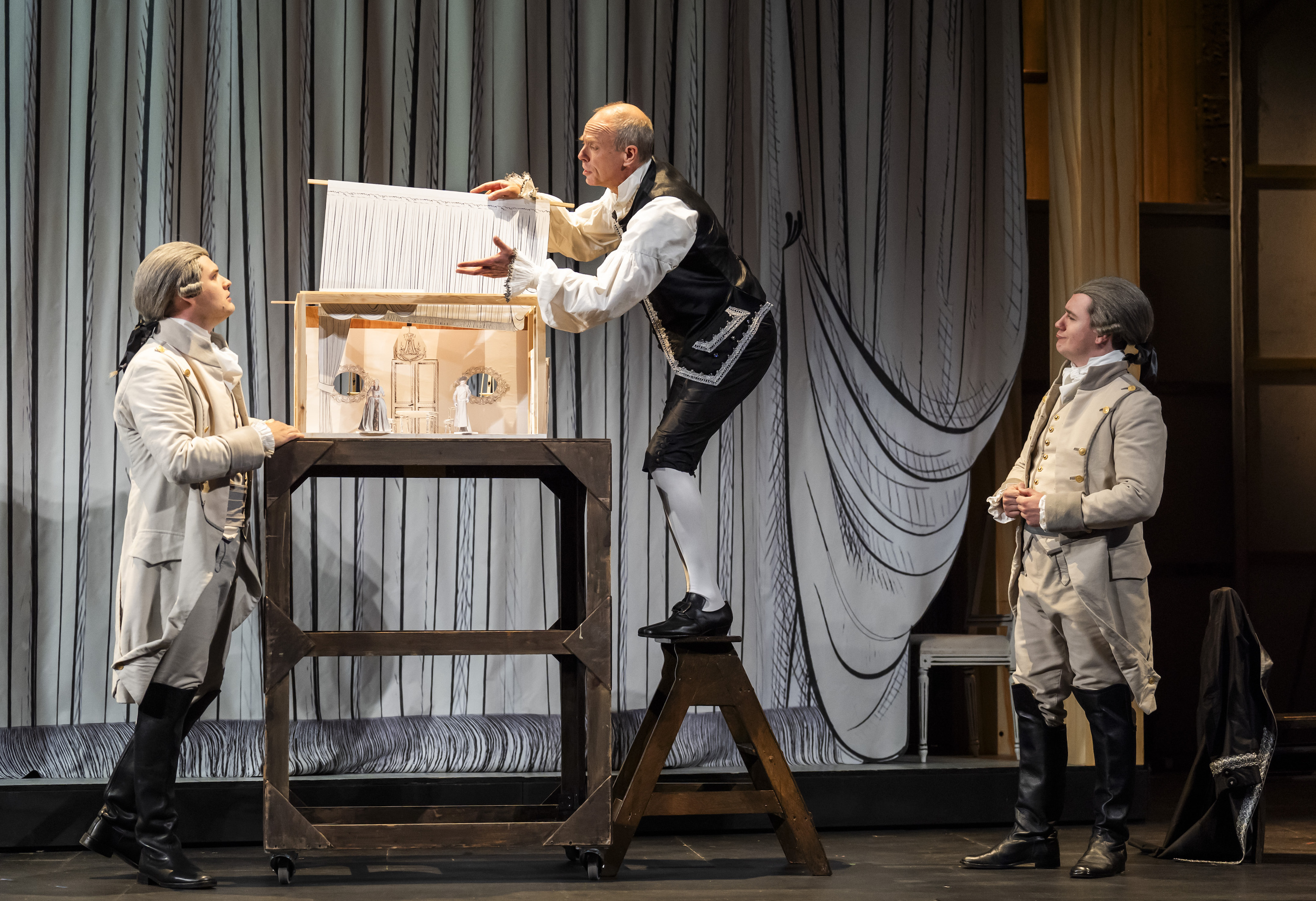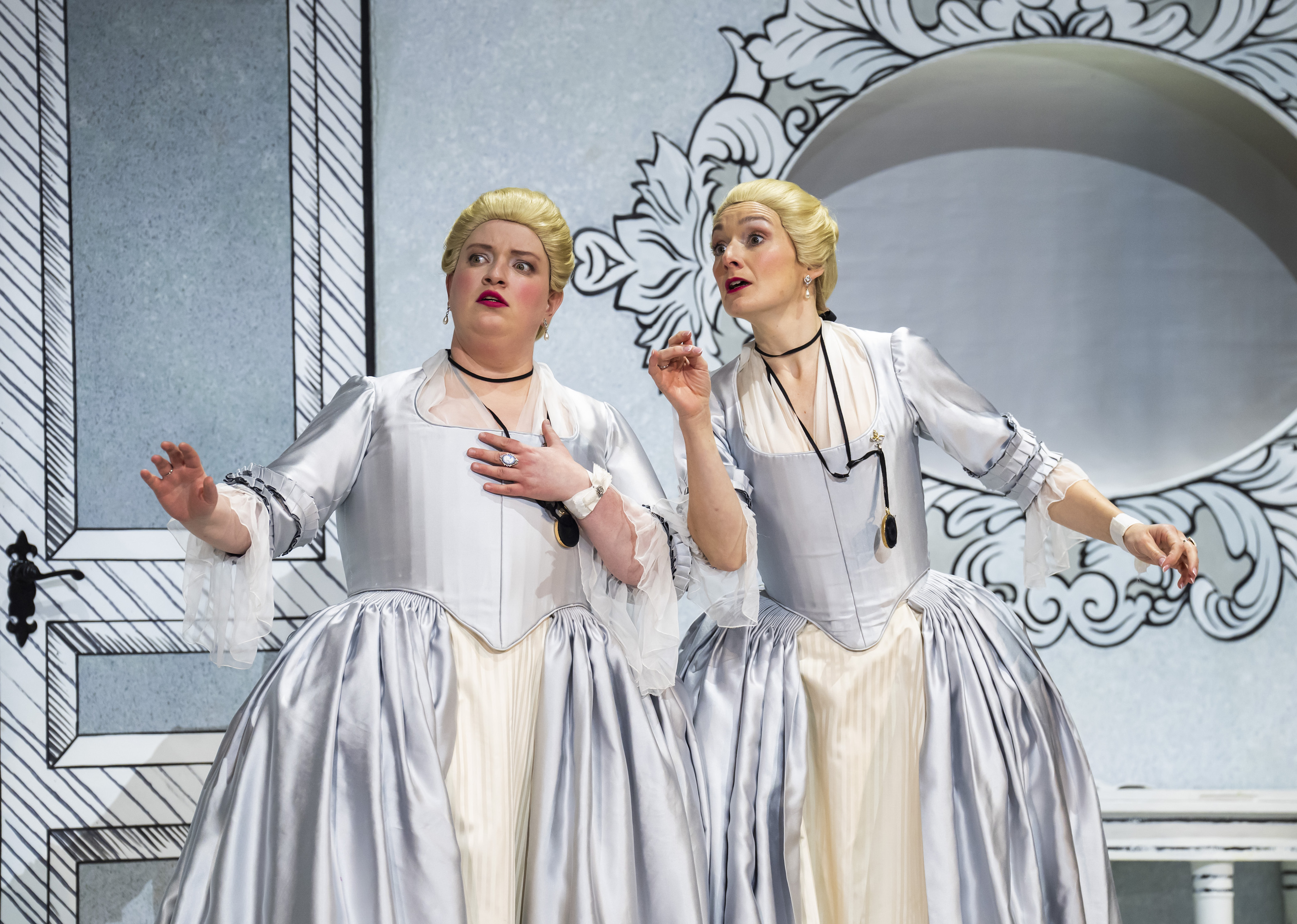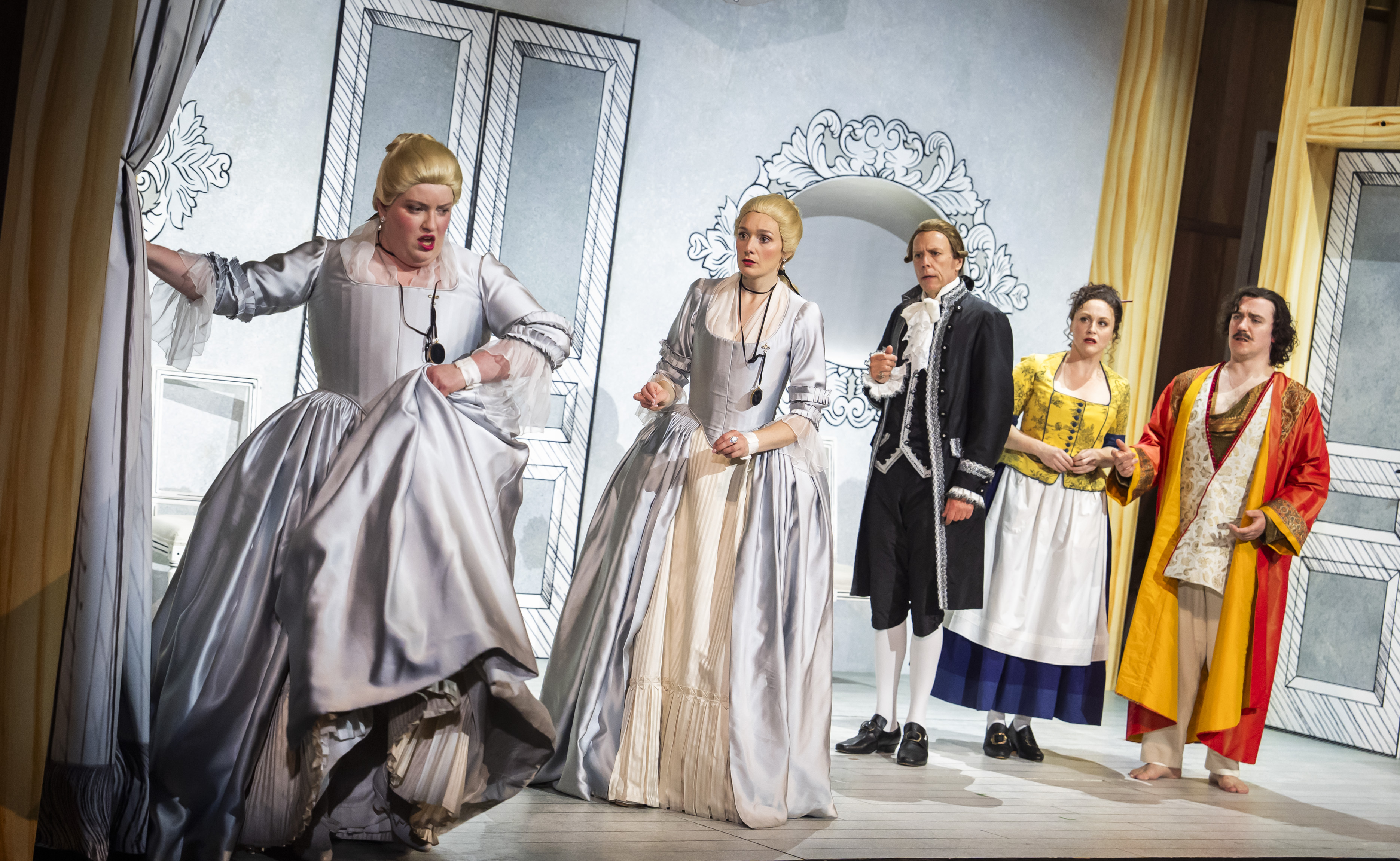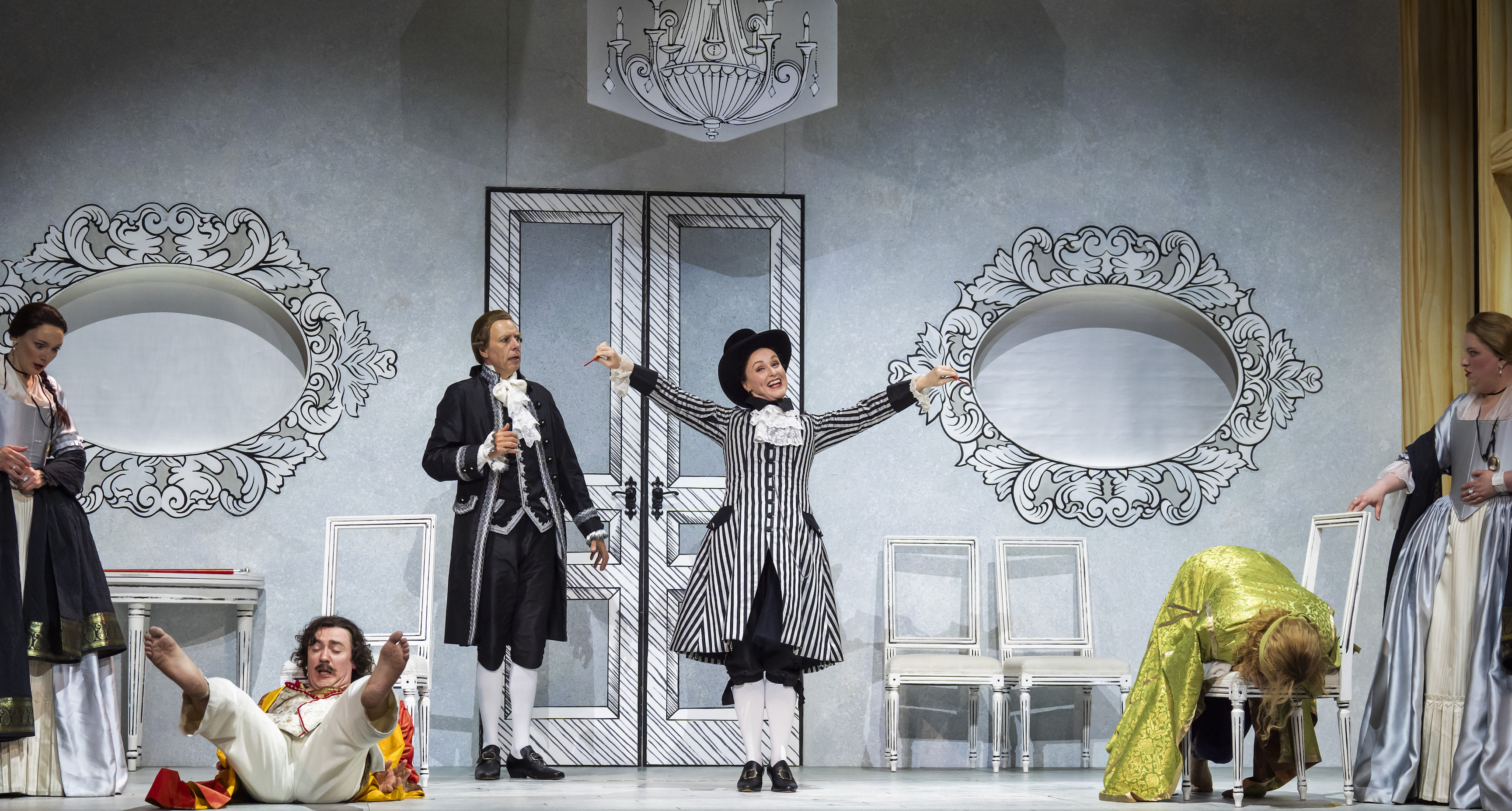Così fan tutte, Nevill Holt Festival/Opera North review - re-writing the script | reviews, news & interviews
Così fan tutte, Nevill Holt Festival/Opera North review - re-writing the script
Così fan tutte, Nevill Holt Festival/Opera North review - re-writing the script
Real feeling turns the tables on stage artifice in Mozart that charms, and moves

Marianne Moore once famously defined poems as “imaginary gardens with real toads in them”. Operas also fill, or anyway should fill, their artificial horticulture with genuine beasts – and flowers. And no work demands the population of a fanciful landscape with authentic passion more urgently than Così fan tutte.
At the Nevill Holt festival in rural Leicestershire, Opera North show how the reality of conflicted human feelings triumph as they break free of this mechanism of deceit. For the company’s first instalment of a five-year deal with the festival, director Cecilia Stinton gives us a nest of theatrical boxes: stages within stages, frames within frames. Alfonso and his male accomplices endeavour to perform their dramatic proof of all women’s fickle and inconstant natures – così fan tutte. Here, however, women can read the script, modify their parts, and turn the tables on the director.
Vigorously supported by the Opera North orchestra under Chris Hopkins, an ebullient young cast bring zest, grace and bittersweet comedy to Stinton’s thoughtful but gimmick-free production. Aided by a witty English-language text delivered with bracing clarity, this Così consistently engages and entertains – while never denying the darkness of the plot.
The Nevill Holt festival now spans various art-forms, but with opera still in pride of place. Its 400-seat theatre, housed in a converted stable-block next to the picturesque low-slung house whose earliest parts predate 1300, reached the shortlist for the RIBA Stirling Prize in 2019, and won the prize’s “people’s vote”. Inside, old ironstone blends pleasingly with new dark wood. With audience-friendly sight-lines, an intimate, involving acoustic and well-designed orchestra pit, the venue make a smart match for chamber-sized Mozart. Stinton and her designer George Leigh stick to compact, lightly-stylised 18th-century interiors and costumes: the downside being that we lose any sense of the open seas beyond Naples, on which the lovers (supposedly) depart for military service as Alfonso’s vicious “experiment” begins. In the production’s favour, the closed rooms become framed laboratory-stages on which Alfonso, as theatrical mastermind, aims to mount his immorality-tale about female infidelity. From the outset, as he scribbles away during the overture at the script that will tell Fernando and Guglielmo how to trick their lovers Dorabella and Fiordiligi, he is the on-stage impresario who seeks to run the whole cold-hearted business. Sometimes the chorus – only eight-strong, but robust and resourceful – do a bit of the directing themselves, while scripts, spotlights, a costume-rail and even a toy theatre extend the backstage conceit (Pictured above: Will Dazeley, centre, with Seán Boylan, Egor Zhuravskii). In Alfonso’s cynical showbiz, women can only be allowed to play the jade’s and hussy’s part. However, actors may rebel against their roles.
Stinton and her designer George Leigh stick to compact, lightly-stylised 18th-century interiors and costumes: the downside being that we lose any sense of the open seas beyond Naples, on which the lovers (supposedly) depart for military service as Alfonso’s vicious “experiment” begins. In the production’s favour, the closed rooms become framed laboratory-stages on which Alfonso, as theatrical mastermind, aims to mount his immorality-tale about female infidelity. From the outset, as he scribbles away during the overture at the script that will tell Fernando and Guglielmo how to trick their lovers Dorabella and Fiordiligi, he is the on-stage impresario who seeks to run the whole cold-hearted business. Sometimes the chorus – only eight-strong, but robust and resourceful – do a bit of the directing themselves, while scripts, spotlights, a costume-rail and even a toy theatre extend the backstage conceit (Pictured above: Will Dazeley, centre, with Seán Boylan, Egor Zhuravskii). In Alfonso’s cynical showbiz, women can only be allowed to play the jade’s and hussy’s part. However, actors may rebel against their roles.
Perhaps Stinton pushes her play-within-a-play motif too hard at times. Scores can be over-fussily consulted at key junctures, although some moments – notably, when Fiordiligi (Ella Taylor, pictured below left, with Heather Lowe) rips up her assigned part at the close of “Come scoglio” – work a treat. And, as each one of the male duo tries to woo the other’s sweetheart when dressed up as romantic foreigners, we see how the manipulators may be manipulated – and how actors may get emotionally entangled in their parts. Stinton, and costume designer Stephen Rodwell, downplay the exoticism of Ferrando and Guglielmo in disguise: no “Albanian” fancy-dress headgear here; just scarlet and green robes that, as the lovers switch affections, match the women’s gowns. Music, rather than millinery, will turn these lovers’ heads, and hearts. Opera North has brought two casts to their Nevill Holt Così, with only William Dazeley’s Don Alfonso common to both. On the opening night, plenty of cohesive ensemble work made the plot-twists admirably clear – helped by lucid diction and that snappy, rhythmic English text. Duets, trios, quartets and the stupendous act-closing sextets revealed singers alert, and responsive, to one another’s movements and the pace of the action.
Opera North has brought two casts to their Nevill Holt Così, with only William Dazeley’s Don Alfonso common to both. On the opening night, plenty of cohesive ensemble work made the plot-twists admirably clear – helped by lucid diction and that snappy, rhythmic English text. Duets, trios, quartets and the stupendous act-closing sextets revealed singers alert, and responsive, to one another’s movements and the pace of the action.
Not quite every aria touched the heights – but many did. If I had to rank the voices, then the liquid sheen and glow of Egor Zhuravskii’s tenor as Ferrando might take the palm, truly sumptuous in “Un aura amoroso” and properly ardent as he falls for the stiffly-resisting Fiordiligi. As the steadfast lover whose rock-like devotion melts into human flesh-and-blood, Ella Taylor’s mighty soprano (pictured below left) is vocally forceful and dramatically compelling. “Come scoglio” becomes a fizzing cameo of defiance, while Taylor’s later convulsions of duty and desire modify their charismatic stage presence with an aching vulnerability. The pair of deeper voices (though the contrast in register here feels less marked than it sometimes does) effectively blended comic agility with lyrical polish. As Guglielmo, Seán Boylan’s refined baritone avoids any lumbering joviality and – for instance in “Non siate ritrosi” – tempers his roguish worldliness with reserves of tenderness. Sometimes skittish but far from lightweight, Heather Lowe's mezzo makes the supposedly flighty Dorabella grounded but not sour; she injects bite as well as charm into pieces such as “È amore un ladroncello”.
The pair of deeper voices (though the contrast in register here feels less marked than it sometimes does) effectively blended comic agility with lyrical polish. As Guglielmo, Seán Boylan’s refined baritone avoids any lumbering joviality and – for instance in “Non siate ritrosi” – tempers his roguish worldliness with reserves of tenderness. Sometimes skittish but far from lightweight, Heather Lowe's mezzo makes the supposedly flighty Dorabella grounded but not sour; she injects bite as well as charm into pieces such as “È amore un ladroncello”.
Despina, the below-stairs schemer who out-foxes even Alfonso, can run away with Così, and Claire Lees on occasions threatened to do that – especially in her commedia dell’arte turns as fake doctor and lawyer (pictured below centre). However, tight ensemble work meant that her sassy showpieces – above all, “Una donna a quindici anni” – knitted snugly into the action that her intrigues do so much to advance. The principal quartet skipped through the farcical elements with a swift and easy touch, with wistful melancholia never more than a heartbeat away. As for the villainous, cold-eyed behaviourist who oversees his cunning plan, Alfonso can be a thankless part – but William Dazeley’s strong-voiced baritone sustained the creepy authority of this string-pulling puppet-master from initial project to final twist. As the men drop their silly disguises and the women return to their original loyalties (or do they?), the music must go on convincing us that the contrived garden – or stage-set – of this plot hosts credible creatures within it. Supported by brisk, flavourful work from the Opera North players (with the woodwinds and horns particularly eloquent), Chris Hopkins helped keep it all real. Ravishing set-pieces – for instance, the sublime trio “Soave sia il vento” – had the pace and pulse that their dramatic purposes require. This nasty tale of deception floats, paradoxically, along on a musical tide of beauty, nobility and sincerity. Amid the gardens of Nevill Holt we encountered some proper toads – and equally genuine flowers.
As the men drop their silly disguises and the women return to their original loyalties (or do they?), the music must go on convincing us that the contrived garden – or stage-set – of this plot hosts credible creatures within it. Supported by brisk, flavourful work from the Opera North players (with the woodwinds and horns particularly eloquent), Chris Hopkins helped keep it all real. Ravishing set-pieces – for instance, the sublime trio “Soave sia il vento” – had the pace and pulse that their dramatic purposes require. This nasty tale of deception floats, paradoxically, along on a musical tide of beauty, nobility and sincerity. Amid the gardens of Nevill Holt we encountered some proper toads – and equally genuine flowers.
- Così fan tutte continues at Nevill Holt Theatre until 12 June
- More opera reviews on theartsdesk
rating
Explore topics
Share this article
The future of Arts Journalism
You can stop theartsdesk.com closing!
We urgently need financing to survive. Our fundraising drive has thus far raised £49,000 but we need to reach £100,000 or we will be forced to close. Please contribute here: https://gofund.me/c3f6033d
And if you can forward this information to anyone who might assist, we’d be grateful.

Subscribe to theartsdesk.com
Thank you for continuing to read our work on theartsdesk.com. For unlimited access to every article in its entirety, including our archive of more than 15,000 pieces, we're asking for £5 per month or £40 per year. We feel it's a very good deal, and hope you do too.
To take a subscription now simply click here.
And if you're looking for that extra gift for a friend or family member, why not treat them to a theartsdesk.com gift subscription?
more Opera
 Tosca, Welsh National Opera review - a great company reduced to brilliance
The old warhorse made special by the basics
Tosca, Welsh National Opera review - a great company reduced to brilliance
The old warhorse made special by the basics
 BBC Proms: The Marriage of Figaro, Glyndebourne Festival review - merriment and menace
Strong Proms transfer for a robust and affecting show
BBC Proms: The Marriage of Figaro, Glyndebourne Festival review - merriment and menace
Strong Proms transfer for a robust and affecting show
 BBC Proms: Suor Angelica, LSO, Pappano review - earthly passion, heavenly grief
A Sister to remember blesses Puccini's convent tragedy
BBC Proms: Suor Angelica, LSO, Pappano review - earthly passion, heavenly grief
A Sister to remember blesses Puccini's convent tragedy
 Orpheus and Eurydice, Opera Queensland/SCO, Edinburgh International Festival 2025 review - dazzling, but distracting
Eye-popping acrobatics don’t always assist in Gluck’s quest for operatic truth
Orpheus and Eurydice, Opera Queensland/SCO, Edinburgh International Festival 2025 review - dazzling, but distracting
Eye-popping acrobatics don’t always assist in Gluck’s quest for operatic truth
 MARS, Irish National Opera review - silly space oddity with fun stretches
Cast, orchestra and production give Jennifer Walshe’s bold collage their all
MARS, Irish National Opera review - silly space oddity with fun stretches
Cast, orchestra and production give Jennifer Walshe’s bold collage their all
 Káťa Kabanová, Glyndebourne review - emotional concentration in a salle modulable
Janáček superbly done through or in spite of the symbolism
Káťa Kabanová, Glyndebourne review - emotional concentration in a salle modulable
Janáček superbly done through or in spite of the symbolism
 Buxton International Festival 2025 review - a lavish offering of smaller-scale work
Allison Cook stands out in a fascinating integrated double bill of Bernstein and Poulenc
Buxton International Festival 2025 review - a lavish offering of smaller-scale work
Allison Cook stands out in a fascinating integrated double bill of Bernstein and Poulenc
 Tosca, Clonter Opera review - beauty and integrity in miniature
Happy surprises and a convincing interpretation of Puccini for today
Tosca, Clonter Opera review - beauty and integrity in miniature
Happy surprises and a convincing interpretation of Puccini for today
 Hamlet, Buxton International Festival review - how to re-imagine re-imagined Shakespeare
Music comes first in very 19th century, very Romantic, very French operatic creation
Hamlet, Buxton International Festival review - how to re-imagine re-imagined Shakespeare
Music comes first in very 19th century, very Romantic, very French operatic creation
 Falstaff, Glyndebourne review - knockabout and nostalgia in postwar Windsor
A fat knight to remember, and snappy stagecraft, overcome some tedious waits
Falstaff, Glyndebourne review - knockabout and nostalgia in postwar Windsor
A fat knight to remember, and snappy stagecraft, overcome some tedious waits
 Salome, LSO, Pappano, Barbican review - a partnership in a million
Asmik Grigorian is vocal perfection in league with a great conductor and orchestra
Salome, LSO, Pappano, Barbican review - a partnership in a million
Asmik Grigorian is vocal perfection in league with a great conductor and orchestra
 Semele, Royal Opera review - unholy smoke
Style comes and goes in a justifiably dark treatment of Handelian myth
Semele, Royal Opera review - unholy smoke
Style comes and goes in a justifiably dark treatment of Handelian myth

Add comment